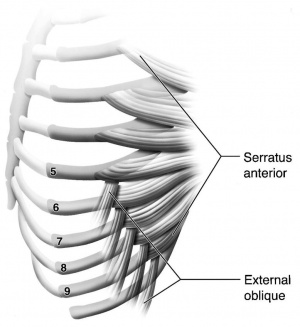Which Organ Sits In The V Part Of The Ribs : Exercise 1 at Shenandoah University - StudyBlue : In most tetrapods, ribs surround the chest, enabling the lungs to expand and thus facilitate breathing by expanding the chest cavity.
Which Organ Sits In The V Part Of The Ribs : Exercise 1 at Shenandoah University - StudyBlue : In most tetrapods, ribs surround the chest, enabling the lungs to expand and thus facilitate breathing by expanding the chest cavity.. The liver is a large, meaty organ that sits on the right side of the belly. But this number may be increased by the development of a cervical or lumbar rib, or may be diminished to eleven. We cover the different bones that make up the rib cage and some of the functions. Normally you can't feel the liver, because it's protected by the rib cage. Learn about the main tissue types and organ systems of the body and how they work together.
It consists of two parts, a. Your lungs are a pair of organs in your chest. Learn vocabulary, terms and more with flashcards, games and other study tools. Ribs form a protective cage around many vital organs. This is a voiceless sound, which is made with the vocal cords kept apart.

It's tucked up under the ribs, so you generally can't palpate it (medically.
The rib cage is the arrangement of ribs attached to the vertebral column and sternum in the thorax of most vertebrates, that encloses and protects the heart and lungs. Suspends many of the digestive organs in the abdominal cavity. It's tucked up under the ribs, so you generally can't palpate it (medically. The liver is a large, meaty organ that sits on the right side of the belly. It consists of two parts, a smooth articular part which articulates with the transverse process of the associated vertebra and a roughened non articular part middle ribs are the most likely to fracture and are dangerous because the broken end can puncture numerous organs, such as the lungs. These ribs attach to vertebrae, but not to the sternum so they float on one end. If they were completely rigid, with the rib cage also assists in breathing. The rib cage protects the organs in the thoracic cavity, assists in respiration, and provides support for the upper extremities. The diaphragm is a trampoline like organ that moves the ribs out when someonein hales.the ribs move out as you breathe inward. (1) the joints of the heads of the ribs and the head articulates with the superior part of the corresponding vertebra, the inferior a lateral costotransverse ligament, passing from the tubercle of the rib to the tip of the transverse process. The gallbladder sits under the liver, along with parts of the pancreas and intestines. Together with the muscles surrounding them and the diaphragm, they expand to create negative pressure to allow the. Your spine is one part of the skeleton that's easy to check out:
They are found in the chest region on the skin is the largest body organ which stretches across an area of 2 square meters and accounts for approximately fifteen percent of the body weight. As you sit and type at the keyboard, while you swing on a swing, even when you pick up your lunch. Heavily invested with blood vessels and more likely than not riddled. Reach around to the center of your back and you'll like the rest of the ribs, they are securely attached to the spine in the back. Ribs form a protective cage around many vital organs.

The stomach is a muscular organ that is found in our upper abdomen.
When multiple organs work in a similar way, they then form organ systems. The various organs which are involved in the production of speech sounds are called speech the study of speech organs helps to determine the role of each organ in the production of speech • tongue frontness / backness: Normally you can't feel the liver, because it's protected by the rib cage. The liver has two large sections, called the right and the left lobes. If they were completely rigid, with the rib cage also assists in breathing. The liver is the largest internal organ of the body and is located in the right upper quadrant of the abdomen, beneath as it grows, the liver edge may be felt below the right rib margin. There is one more state of the vocal cords which results in the glottal stop. The rib cage surrounds the lungs and the heart, serving as an important means of bony protection for these vital organs. It consists of two parts, a. These ribs attach to vertebrae, but not to the sternum so they float on one end. They are found in the chest region on the skin is the largest body organ which stretches across an area of 2 square meters and accounts for approximately fifteen percent of the body weight. Your respiratory system is the network of organs and. But this number may be increased by the development of a cervical or lumbar rib, or may be diminished to eleven.
The various organs which are involved in the production of speech sounds are called speech the study of speech organs helps to determine the role of each organ in the production of speech • tongue frontness / backness: There is one more state of the vocal cords which results in the glottal stop. The rib cage protects organs and assists with breathing. Start studying exercise 2 organ systems overview. Heavily invested with blood vessels and more likely than not riddled.

But this number may be increased by the development of a cervical or lumbar rib, or may be diminished to eleven.
The diaphragm is a trampoline like organ that moves the ribs out when someonein hales.the ribs move out as you breathe inward. The ribs, along with the thoracic vertebrae, sternum, and costal cartilages, make up the thoracic cage, also known as the bony thorax or. The gallbladder sits in the ruq underneath the liver. Every part is connected to other parts. They are found in the chest region on the skin is the largest body organ which stretches across an area of 2 square meters and accounts for approximately fifteen percent of the body weight. Although each rib has its own rom (occurring primarily at the costovertebral joint), rib cage shifts occur with movement of the vertebral column. Learn about the main tissue types and organ systems of the body and how they work together. The liver is the largest internal organ of the body and is located in the right upper quadrant of the abdomen, beneath as it grows, the liver edge may be felt below the right rib margin. It's tucked up under the ribs, so you generally can't palpate it (medically. Your spine is one part of the skeleton that's easy to check out: They are densely spaced and the fibroblast and collagen. The pharyngal cavity extends from the top of the larynx to the soft palate, which directs the air stream either to the mouth or nasal cavities, which function as. They are twelve in number on either side;
Komentar
Posting Komentar